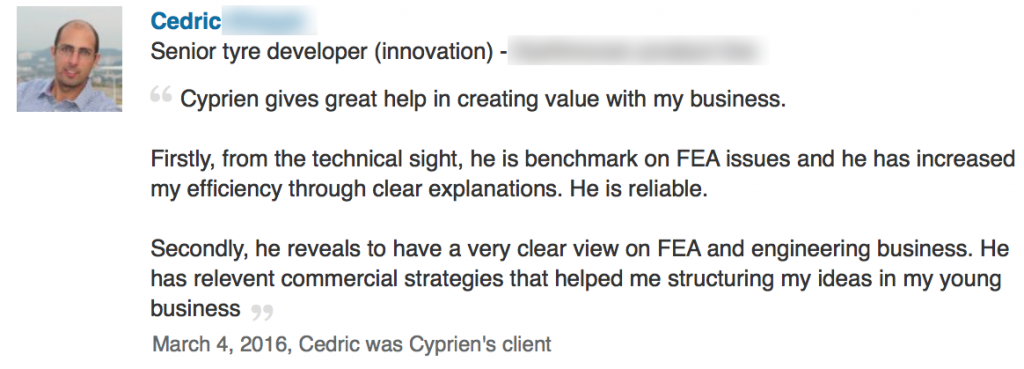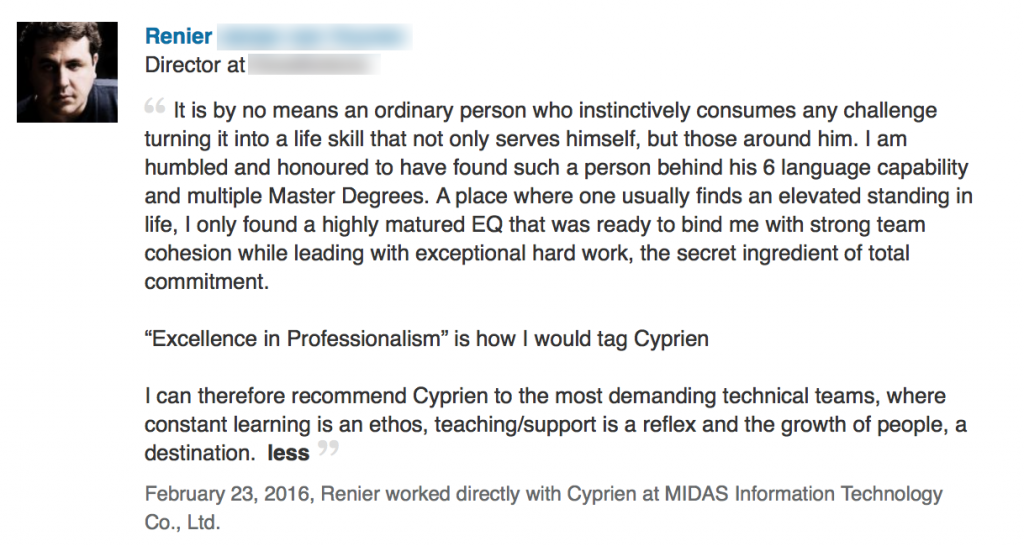
Why has meshing so much impact on my results?What are the hidden rules behind meshing accuracy?
I pondered those question a long long time before being able to get any straightforward answer…
In fact…
When I started to learn FEA a few years back, I had so many problems in my model, I didn’t know where to start.
I had a model and a software, but I just didn’t know how to get accurate results…
I knew the theory and the mathematics, but I had never really worked on a real project and the perspective to do that was frightening.
I feared that my boss would discover that I didn’t really know how to simulate a real system and that I would be fired…
At that time, I just asked the engineer who was with me and he told me:
« start with the tutorials, you will have a good basic understanding »
I did that of course…
But after finishing all the tutorials, I felt like I just knew how to push a few buttons… and that was all I could do…
I realized quickly that learning FEA is different than learning to use an FEA software…
So I started to go online and search for books and courses, but the only resources available seemed to be old textbooks and some expensive professional training websites.
I had many problems and questions at that time:
Why does everyone focus so much on getting colorful results rather than engineering results?
I observed with fascination the people who boasted on the web about getting great « stress colors» without actually caring too much about the inner relevancy of those results.
Over time, I wanted to tell them that FEA was all about getting engineering data to do something meaningful with it…but afterward, I realized that I couldn’t blame them because it’s so difficult to find real pieces of advice online…
Most of what I used to find was hidden advertisement for FEA software solutions showing… well… beautiful colorful results.
Why are « accurate results » so important?
When you start doing FEA, you quickly realize that accuracy is critical. If your model is bad, you can get very unrealistic results…and that’s bad because then an FEA software isn’t so much different from an interesting game.
If the input is wrong, FEA is just garbage in, garbage out…
Why does everyone talk about automation without even understanding the correct way to do FEA?
When you search for the right way to mesh a model, you find a lot of people telling you that you shouldn’t worry too much about it, you can just use « Automeshing » and everything will be « mostly » fine.
All the nuance is in this word: « mostly »…
Is it really true that auto meshing is so powerful?
Why no one teaches how to mesh correctly in school?
I attended a few courses back then, but everything was always too theoretical and focused on the equations rather than on the real stuff
One of the reasons I discovered later on, is that professors teaching FEA were mainly knowledgeable about the theory, but not so much about how it actually works in practice when you have a mechanical system to design quickly and efficiently and that nothing is working out like in the tutorials…
Why are there so many free articles on the internet but none of them seems really useful to understand FEA in depth?
If you have ever searched for quality articles online, you probably know how much it is difficult to find good and relevant content.
Most of the people out there say one thing and its contrary and it’s difficult to know who you can actually trust to have the correct answer!
What about online courses?
There ARE courses and books, but why do they all seem so outdated and filled with complex equations that won’t really help us to solve practical engineering problems?
We live in the internet area and there gotta be something better than that…
After few years of practicing FEA on real projects, I started to understand the strategy to perform FEA correctly…and it was very different than what I have been taught.
THE ENGINEER VIEW
Creating a realistic model
FEA isn’t a game and it isn’t also some kind of extension of the design process. FEA is about building a model that will represent correctly the physics behind the mechanical part or system that you try to simulate.
Why isn’t Automeshing always good?
FEA is not about getting a finite element model as close a possible to the CAD model, even if this is what the companies selling CAD-embedded FEA would like you to believe.
FEA is about getting engineering data and results that will help you to take some important decisions for a mechanical product or system. For example, knowing if the security factor of a specific design isn’t too low, because it would be dangerous, or too high, because engineers don’t want to over-engineer either.
Is meshing everything?
You need, of course, to get an accurately meshed model which will depict accurately the physics of your system and provide meaningful data to you, but that’s not everything.
FEA requires you to understand a lot of different concepts such as selecting correct boundary conditions or defining correctly the material data and the analysis type you will perform before being able to actually create an FE model and get simulation results.
How to get accurate results?
Getting accurate results comes from understanding the whole picture of how FEA actually works.
I called this global view the « FEA system ».
Once you understand the foundations of this FEA system, you start to know exactly which parts of the system influences most the accuracy of your model and you start to see a very distinctive pattern that will help you to get accurate results every time by changing your model or the system itself.
THE FEA SYSTEM VIEW
I started to see FEA as a coherent system that, once studied and understood, lead to a higher understanding of mechanical models and parts.
The truth is that it takes some time to develop a system vision of FEA, but when you understand that, everything become faster and easier.
I made a video which explains what I mean by “FEA System”:
The advantages of a system are multiple:
- You get the assurance that your results are accurate enough every time
- You know that if there is a problem, there is a way to fix the system to correct the problem
- You know which problems FEA can solve and you instantly see how
The system view empowers you to have more confidence into your simulation and in your results because it gives you a way to be sure that they are accurate.
HOW CAN YOU LEARN AND MASTER FEA?
If you are a just starting to use FEA, or even if you used FEA for some time but you still get some problems, what I will share with you will probably be very interesting.
As it takes time to explain how to learn FEA, I created the following video which explains everything:
PS: you won’t find anyone out there explaining that, so… take some notes ;-)
Some of my readers and friends also felt the need for a structured web series about FEA
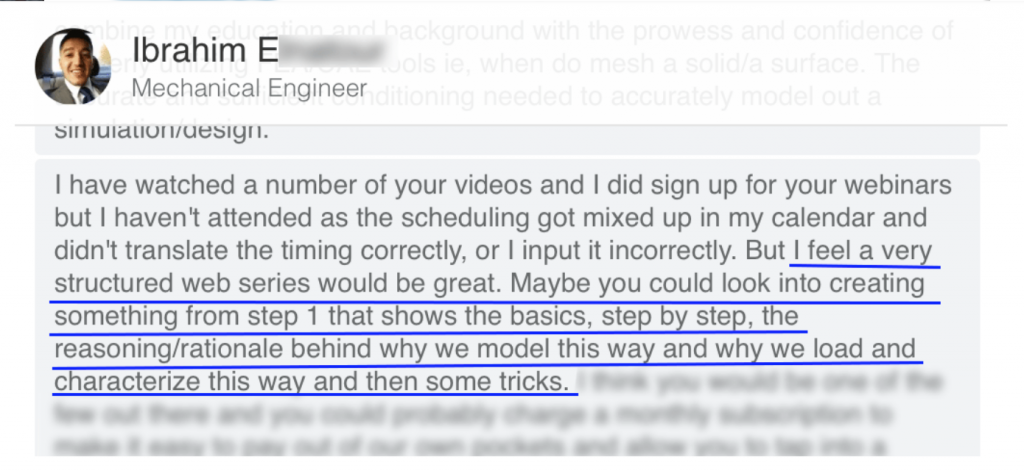
FEA FOUNDATIONS COURSE SERIES
To master a wide topic such as the FEA System, you need to learn the foundations first, because no one can build a solid house without starting by building solid foundations.
To have an accurate understanding of the whole FEA system, you need to have first a detailed understanding of its basic blocks: The geometry, the material, the boundary conditions, the FE model and the meshing, the theory, the types of analysis, the solvers, the algorithms,…
That’s the principle behind this course series:
Each course will teach you in details all the knowledge and the best practices through a series of videos created especially to bring you to an advance understanding of all the basic foundational blocks of FEA.
I have already launched the first course: “FEA foundations: Perfect BC” a few months ago and that was the step 1.
Now is coming the 2nd course of the series“FEA foundations: Mesh Convergence”!

FEA FOUNDATIONS: MESH CONVERGENCE
This course has only one purpose: Making you ready to understand everything about meshing so you can get accurate results out of every FE model you build… in the most efficient way.
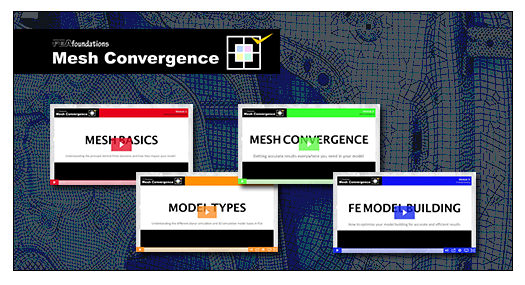
No time lost trying to select the right type of model or element. No time lost trying to solve meshing problems that are straightforward once you know how to build efficiently great FE models…and the assurance to get a quality mesh that will give you always the most accurate results.
It integrates practical examples and actionable step-by-step algorithms and techniques that will give you all the tools to handle any kind of meshing problem!!
With this knowledge, you will not only learn to solve quickly your mesh convergence headaches, but you will also learn to use the power of FEA to solve real engineering problems and become an expert in FEA!
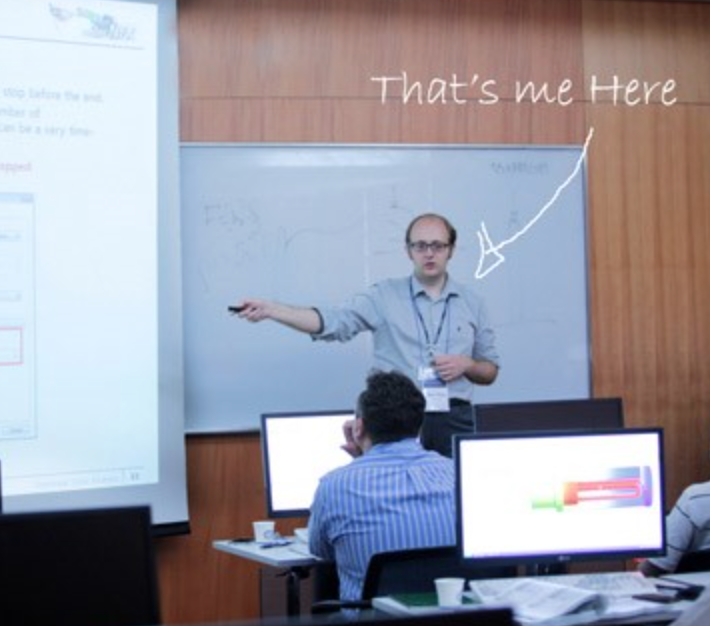 Being a great engineer is all about having the right frameworks and systems to detect, analyze and solve real problems that appear in everyday’s life… and this is exactly what I am providing in this course!
Being a great engineer is all about having the right frameworks and systems to detect, analyze and solve real problems that appear in everyday’s life… and this is exactly what I am providing in this course!
This is far the best material I ever created on FEA meshing!
Hundreds of FEA students followed my free webinars on Youtube, but this course is definitely the most advanced material you will ever get on meshing techniques and strategies!
Is this course good for me?
- If you are a student who wants to learn more than what is actually taught in your school to become efficient and learn about the best FEA practices in meshing, then this course is for you!
- If you are a designer who would like to become proficient in FEA and learn some practical techniques that haven’t been taught to you in order to complete a design project in the best and the most efficient way, then this course is for you!
- If you are an FEA analyst who would like to upgrade or maybe refresh your knowledge about meshing techniques and best practices, then this course is also for you.
- If you are a professor who understands meshing well, but who would like to acquire some easy way to present this difficult topic to you students, then this course may be for you.
What is in the course?
This course is a complete « at your own pace » online video course composed of more than 4 hours of video and other material. Once you joined the course, it becomes available to you forever. Just log into the course system and access to the videos, PPTs and articles that you would like to read.
It is the first Finite Element Analysis Online Course which is solely based on understanding the concept of meshing convergence and the practical strategies to create some mesh that will lead to accurate results.
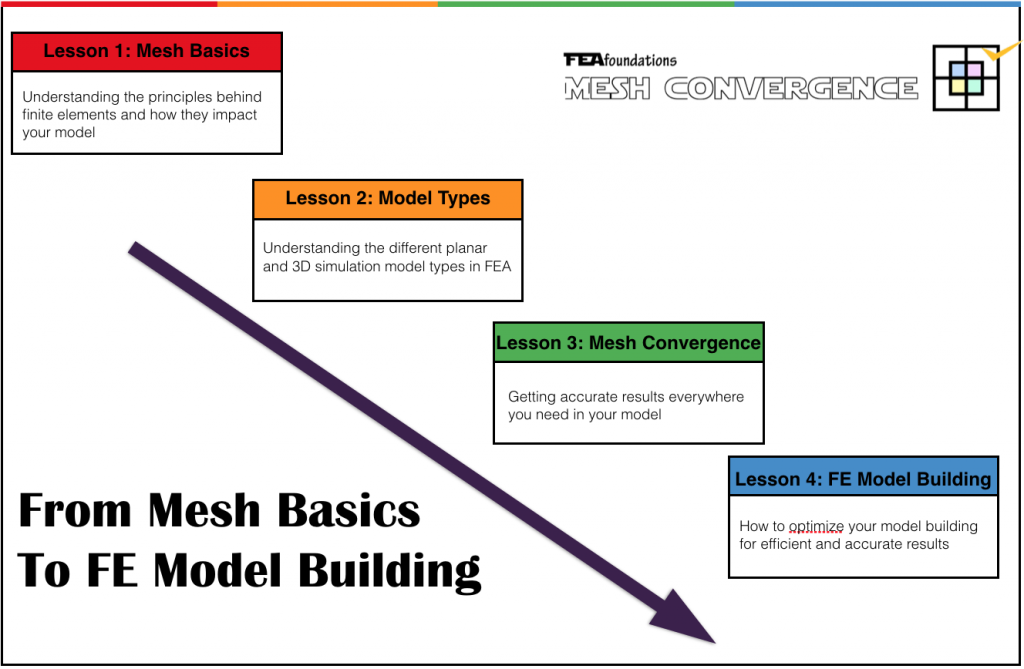
Lesson 1 — Mesh Basics: Understand the principle behind finite elements and how they impact your model
To understand how meshing works and how it impacts your results, you have first to understand what is a finite element and how your finite element model creates a realistic representation of your mechanical system.
In this first lesson, I tried to compact and simplify the concepts behind finite elements to reduce it in a simple analogy which will immediately make you understand the concept of stiffness and how displacement, strain, and stress results are actually calculated in your model.
Finally, I will give you 3 guidelines that will help you to make a proper mesh for your FE model. Those guidelines will be refined and complemented with practical strategies and techniques in the next lessons of the course.
Lesson 2– Model Types: Understanding planar and 3D simulation model types
An accurate and efficient FE model is first and foremost about choosing the right way to model the physics behind the mechanical system you are simulating. The simulation isn’t always as simple as clicking on a button to auto-mesh a 3D CAD model. There are a lot of ways to represent and simulate reality more efficiently and more accurately also.
In this lesson, I will teach you first few useful rules to choose a model type and I will talk about the impact it has on your simulation. Then I will describe to you in details the various planar and 3D model types and their detailed characteristics. We will see in details:
- Plane stress models
- Plane strain models
- Axisymmetric models
- Symmetric models
- Beam models
- Shell models
- Solid models
- Special elements used in various models
Lesson 3– Mesh Convergence: Getting accurate results everywhere you need in your model
The link between meshing and accuracy is probably one of your first concerns when you mesh a model. This is what we will be talking about in this lesson.
You will learn why meshing has an impact on the accuracy of your model and how to improve the accuracy of your results using the concept of « mesh convergence ».
Finally, I will give you 3 practical methods to check and improve mesh convergence in your model everywhere you need, along with some practical exercise that will sensibilise you to understand the accuracy of each element type.
Lesson 4 — FE model building: How to optimize your model building for efficient and accurate results
This lesson is where you will learn the practical knowledge to put in application everything you learned during the first 3 lessons about meshing.
I will teach you some techniques to plan and set up your model for FE simulation along with few practical techniques that will accelerate the efficiency of your model preparation workflow. Those techniques will help you to mesh bigger models in less amount of time without compromising the quality.
I will finally tell you in the lesson the advantages of manual meshing, that I will compare with auto-meshing using 5 basic criteria.
Then, we will review each type of 3D model type that I describe in the lesson 2 (Beam models, Shell models, and Solid models), and I will show you how to mesh each of those model types in the best possible way from planning to execution and with practical illustrated step-by-step tutorials and example.
Warning: Each of those lessons is totally software independent as everything is based on common general knowledge and practices of finite element modeling and simulation. For practical tutorials, the software I have used is the software midas NFX. The workflow is very similar to other similar advanced FE preprocessor software such as Abaqus, Nastran, Femap,etc. … and easily reproducible within your own software.
How do I join the course ?
- Purchase the course by clicking on the Purchase button below
- You will be redirected to the paypal website where you have to enter either your paypal credentials or directly your credit card information if you do not have a paypal account
- After completing the purchase on paypal, you will receive an email with your student login and password
- Using these credentials, you can log into your courses section where you have a lifetime access to your course “FEA foundations: Mesh Convergence”
How much does the course costs?
- The lifetime access to the course costs 97$ if you purchase it before the 11th of November 2016.
- Please note that this cost will increase next time the course will be launched as the course will be improved over time
- If you purchase it now, you will have access to all the new materials added and the revisions made to the course
I also provide you a 30 days money back guarantee, so you can try the course for 30 days and if you aren’t fully satisfied, I’ll send you back the money without any question asked.

TESTIMONIALS


